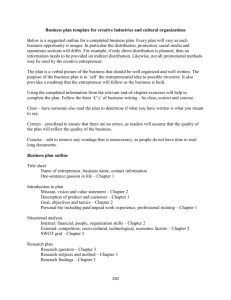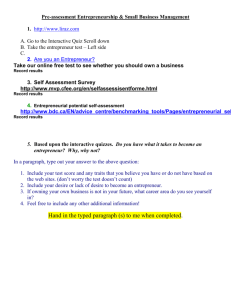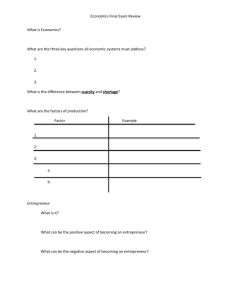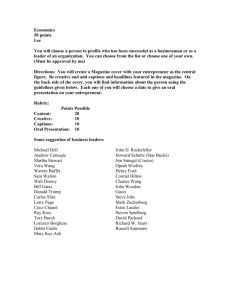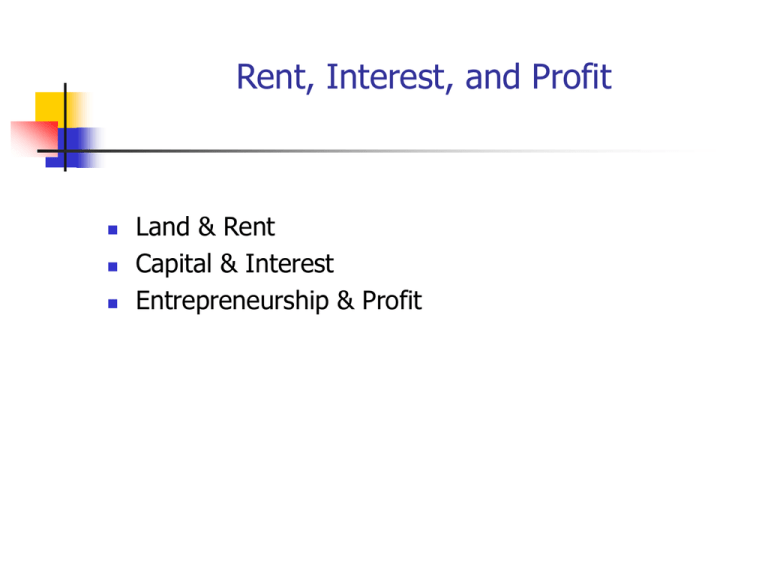
Rent, Interest, and Profit
Land & Rent
Capital & Interest
Entrepreneurship & Profit
Land & Rent
Land is defined as raw earth
Also includes
•
•
•
•
Minerals and resources buried in the land
Crops that can be grown on the land
Timber
Etc.
Does not include what is constructed on the Land
How land is used depends upon a number of factors
•
•
•
Location
Fertility
Minerals
How Land is Utilized
Highest and best Use Principle
Without some form of regulation, land will migrate to
the use that people are willing to pay the most
Location is a key determinant of what the various
demands for land will be
•
Land located at the corner of 57th streets and Fifth avenue in
Manhattan is worth considerably more than the same
quantity of land located in downtown Tonopah, Nevada
Supply of & Demand for Land
The Supply of land is virtually fixed
When the supply of a product or factor is fixed, its
supply is represented by a vertical line
The demand for land, like all factors will be
determined by a firm’s MRP curve
So, in absence of regulation, land will migrate to the
firm willing to pay the most for it
Determination of Rent
S
10,000
The demand for rent is the MRP
schedule of the highest bidder for a
specific piece of land. The supply of
land is fixed, so its supply curve is
perfectly inelastic. The rent, like the
price of anything else, is set by supply
and demand
8,000
6,000
D
4,000
2,000
Amount of land
Copyright 2002 by The McGraw-Hill Companies, Inc. All rights reserved.
30-8
Increase in Demand for
Land
S
200,000
Since the supply of land is perfectly
inelastic, an increase in demand is
reflected entirely in an increase in
price (and not an increase in the
quantity of land).
160,000
120,000
D2
80,000
D1
40,000
Amount of land
Copyright 2002 by The McGraw-Hill Companies, Inc. All rights reserved.
30-9
Economic Rent
Payment in excess of what people would be willing to accept is
called “Economic Rent”
It is a result of a fixed supply and a high demand
Ethical question – Since land wasn’t created by landlords, does
it not properly belong to society?
What right do current landlords have to extract rent from
something that was always there
•
•
•
Rents should be taxed – Henry George (1879)
Since God created the earth, only He is entitled to collect rent –
Pierre-Joseph Proudhon
A strong current in historical economic thought denies the
landlord’s claim to rent
Economic Rent, Continued
However; since price guides the use of land, price
ensures that land is used for its most productive
enterprises
Are prices high because rents are high?
Or, are rents high because prices are high?
Answer – Rents are high because of the opportunity
to generate profits – So, profitable locations bid up
rents
Therefore, desirable (profitable) locations bid up
rents
Capital & Interest
Capital is the plant, equipment and machinery used
in the production process
Stock verses Flow
•
•
Stock equals a quantity of something at an instant in time,
such as the stock of capital -- How much capital we have at
a moment in time?
Flow is an “over time” concept – How much additional
investment in capital takes place over a year?
The Demand for and Supply of Capital
The Demand for Capital is determined by the firm’s MRP
for capital
The supply of loanable funds (the financial source of
capital) is not fixed, but will be increased as the price of
loanable funds (the interest rate) is increased
The history of the western world did not condone the
making of money on money itself – Usury – Religious
thought that collecting of interest was a sin
We still have usury laws on the books in all states
To the economist, usury laws are price ceilings and cause
a shortage of loanable funds & disrupt the price
mechanism
How Is the Interest Rate Determined?
The interest rate is determined by
the demand for loanable funds and
the supply of loanable funds
S
16
14
12
10
8
6
D
4
2
Q1
Quantity of loanable f unds
The supply of loanable funds (or savings) slopes upward to the right because the
amount of money people save is somewhat responsive to interest rates
Copyright 2002 by The McGraw-Hill Companies, Inc. All rights reserved.
30-13
The Present Value of Future Income
A dollar in my hand today is worth more than a dollar I expect
to receive at some point in the future
“A bird in the hand is worth two in the bush”
Why?
•
•
•
•
Inflation may lower the value of expected income
Risk that expected income may not be realized
The opportunity cost of not having expected income now
These factors are represented as an interest rate (discount rate)
which discounts future expected cash flows to a present value
Present Value of Future Income
Present value of a dollar received n years from now
= 1/(1+r) to the nth power
If the discount rate = 8%, how much is the Present value of
$100 expected two years from now?
Answer = 1/1.08 squared = 1/1.1664 x $100
= .8573388 x $100 = $85.73
This is the basis of all “return on investment” calculations in
financial investment decisions
Entrepreneurship and Profits
Unlike other factors of production, profit is not
determined by the supply of and demand for
entrepreneurship
Profits are considered a residual from Total Revenue
after the payment of rent, interest, and wages
One could argue that since all other factors are
determined by supply and demand, profits are
indirectly determined by these forces
Your author estimates profit to be about 18.5% of
the Nation’s National Income
Theories of Profit
Economic profit is the reward for recognizing a profit
opportunity and taking advantage of it
Theories overlap, but see the entrepreneur as one
who sees an advantage and grabs it
Theories
•
•
•
•
The
The
The
The
entrepreneur
entrepreneur
entrepreneur
entrepreneur
as
as
as
as
a risk taker
an innovator
a monopolist
an exploiter of labor
The Entrepreneur as a Risk Taker
The only way to get someone to risk money is to
offer a high reward (economic profit) as an incentive
Economic profit is associated with uncertainty;
nothing ventured, nothing gained
Entrepreneurs are willing to take the risk in return for
the opportunity of a large reward
Profit is the reward for risk bearing
The Entrepreneur as an Innovator
An invention is not the same as an innovation
Innovation includes invention but also carries the
business process from production to marketing to
profit generation; that is, it is the commercialization
of the invention
It is the effort to carry an invention through to its
logical conclusion – the generation of a profit
Joseph Schumpeter, noted Harvard economist, even
stated that innovation and financial risk are two
separate components – Financial risk is interest
The Entrepreneur as a Monopolist
The entrepreneur takes advantage of the idea of
exclusivity to monopolize a product or service
Natural scarcity – to do it first and thereby lock out
potential competitors
Contrived scarcity – to corner a market on a vital
resource or gain economic power to limit competition
and generate profit by reducing production and
raising prices
•
•
•
DeBeers (diamonds)
Early Railroads
National Football League
The Entrepreneur as an Exploiter of Labor
Karl Marx – The Capitalist exploits the value of Labor
If the worker could produce enough value to sustain
life by working six hours/day, but is forced by the
capitalist to work 12 hours a day for six hours of
value, the capitalist expropriates 6 hours of labor’s
value for himself
The capitalist uses the value of those six hours to
purchase even more capital to exploit even more
labor
The surplus value of labor is the capitalist’s profit
Profit
We call profits as the income of the
entrepreneur or say that profit is the reward
for the services of the entrepreneur.
We can simply define profits as the reward
received by the entrepreneur for his
contribution to the production process.
The excess of income from the sale of
production over his costs of production is that
we generally call profit.
Profit = Total Revenue – Rent – Wages Interest
Definition of Entrepreneur
Here, Entrepreneur is one who takes
the initiative of starting a business,
organises it and employs other factor of
production. He bears risks and takes all
types of decisions regarding production.
Definition of profit
According to Marshall, Taussig,
Robertson and Bober have defined
profits as ‘the residual payment, what is
left to the producer’s income after all
the other payments have been met.”
According to Drucker, “ The surplus of
current income over past cost is profit.”
Types of Profit
Profit
Gross Profit
Net Profit
Gross profit
What is commonly called ‘Profit’ is gross
profit. Generally by profit we mean that
part of income of firms which is
available to them after all the payments
to the three factors of production.
In other words, Gross profit is the
excess of revenue over total explicit
costs (direct).
Net Profit
Net profits are the profits which accrue to an
entrepreneur for his functions as an
entrepreneur. These functions include risk
bearing ability, innovating spirit etc.
According to Snider, “The economist defines
profits as the excess of sales receipt over
explicit plus implicit expenses of production.”
Theories of Profit
Wage theory of profits
Marginal productivity theory of profit.
Clark’s dynamic theory of profits.
Schumpeter’s Innovation Theory of
profit


